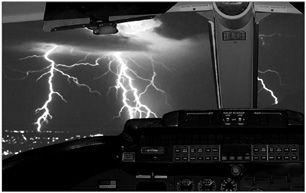
By the time you read this, winter will have set in and, if you live just about anywhere in North America, the short days, biting cold and gusty winds may have you yearning for the lazy, hazy of summer. But with those hazy days come thunderstorms and a much different weather calculus than you have to deal with in the winter.
No matter which time of year we find the most challenging to fly, turbulence is always a factor, whether for operational reasons or simple comfort. Many kinds of turbulence are predictable: Just try the leeward side of the Appalachians after a cold front has moved through. Other kinds-like clear air turbulence, or CAT-are harder to find, but of no less interest.Unfortunately, theres no good way to detect and plot CAT. Or is there?
Over the years, many operators have reported their panel-mounted sferic-based lightning detection equipment-like a Stormscope or Strike Finder-would occasionally plot some strikes where there was only clear air, like the lee side of a mountain range near Albuquerque, N.M. Since there was no thunderstorm activity, they bored on through but had an E-ticket ride. The conclusion they draw is that their sferics devices are plotting turbulence.Can a sferics device reliably detect and plot CAT?
Sferics 101
Sferic devices are designed purely to detect the electrical activity associated with thunderstorms. Sferics is shortened from the word atmospherics and basically means atmospheric discharges. Examples of sferic devices dedicated to thunderstorm detection for aviation include L3 Avionics Systems (formerly Ryan and 3M) line of panel- and remote-mounted Stormscopes, as well as Insights Strike Finder.
Early sferic aviation devices were just that-early. Later-generation products are much better at discriminating lightning strikes. But, many of the same drawbacks of airborne radar (see sidebar) afflict sferics units, also. For example, neither can see beyond a certain range. Meanwhile, any of the new-tech graphical weather displays designed for cockpit use can pan ahead to look at the weather more than 1000 miles away.
Since a sferics device detects electrical activity, and since different pockets of turbulent air can generate electricity as they bump and grind together, wouldnt they detect and plot the phenomenon?
In one sense, lightning strikes are not all that different from the static electricity produced by normal atmospheric energy. In fact, the American Meterological Society defines electrical storm as a relatively rare condition … that arises when strong winds are blowing and much dust is in the air, but involving no thunderstorm activity.
Whats The Frequency?
Some weather research suggests the differences between a lightning strike and the much more benign electrical discharges that occur outside of thunderstorms are fewer than the similarities. The issue of whether an sferics device can plot turbulence really comes down to whether the frequencies monitored by the device are those emitted by phenomena like electrical storms.
A number of meteorologists have found that lightning strikes create electromagnetic (EM) radiation throughout the entire spectrum but do not produce equal amounts of energy at every frequency. For example, lightning tends to generate high-power emissions in the frequency band assigned to television. Similarly, old-timers tuned their ADF receivers to the low end of the AM band to hear thunderstorms, or at least their static.
But, on which EM frequencies can we find the emissions from areas where CAT or electrical storms might be found? Good question, and theres no good answer. The problem is that no one has looked at detailed atmospheric EM emissions and then correlated them with anything but thunderstorms.

What The Experts Say
To get a better idea for the suitability of aviation sferics devices, we asked L3 and Insight which frequencies their devices emphasize. When we asked Insight on what RF frequencies does the Strike Finder listen for lightning, we were half-jokingly told that information was top secret.
L3 was more forthcoming, but stressed up front that their Stormscope line of sferics devices has never been marketed as turbulence detectors. The problem, according to Ron Kivel, an engineer with the company, is that it would be false advertising for them to suggest that an absence of plotted strikes meant the air was totally smooth.
At the same time, Kivel acknowledges there have been documented cases of a lightning-like electrical discharge associated with two differently charged air masses bumping into each other. Thats the basic ingredient for clear-air turbulence.
Basically, if the static discharge is strong enough, and if the sferics device listening on the right frequency is sensitive enough to detect it, CAT can and will be plotted. Kivel was more forthcoming on the frequencies monitored/emphasized by the L3 line of sferics devices, but would only say that the frequency characteristics of the earlier Stormscopes-like the WX-7, -9 and -10-were narrower than current-generation models like the WX-500, -900 and -950.
As he sums it up, for every lightning strike you see, there are maybe a hundred that you dont. That said, Kivel reminded us that sferics devices detect and plot where lightning strikes were and are, not where they will be when you fly into the area.
The Verdict
Sferic devices plot EM emissions in the atmosphere and are optimized to detect thunderstorm-related lightning. Meanwhile, other weather phenomena can also generate emissions detectable with sferics-many of them may involve turbulence. But the converse is not necessarily true: Just because an sferic device does not plot a strike, it doesnt mean the air is smooth.
And thats pretty much the bottom line. While panel-mounted sferics devices are not marketed or intended as turbulence-avoidance equipment, any lightning strikes they plot in clear air could mean turbulence. The next time youre droning along in clear air and your Strike Finder plots lightning where there are no clouds, you might want to slow down and buckle up, or just deviate around the area. But, even if your sferic device displays nothing, that clear air ahead could still be bumpy.
Also With This Article
“Revolutionizing In-Cockpit Weather”
“Other Turbulence Detection Technologies”




